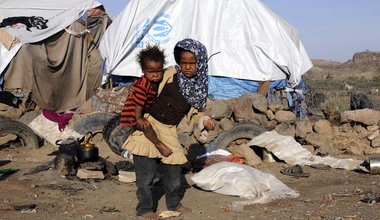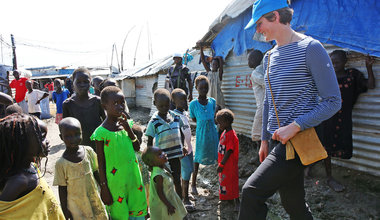DESA - Getting the numbers right on human mobility
Tracking the movements of refugees and migrants across the globe has been at the heart of Bela Hovy’s work for the past 20 years. As the Chief of the Migration Section in UN DESA’s Population Division, he and his team ensure that the international community has accurate data to help promote safe and well-managed international migration.
The Secretary-General’s new report, ‘In Safety and Dignity: Addressing Large Movements of Refugees and Migrants’, was just about to be launched when UN DESA’s communications team got a chance to speak with Bela Hovy, who has led the Migration Section in UN DESA’s Population Division since 2006, and who was previously in charge of statistics at the United Nations High Commissioner for Refugees (UNHCR).
Mr. Hovy shares the efforts involved to make sure that we have correct data and the department’s role in providing input to this new report of the Secretary-General, as well as the work ahead to support the preparations for the upcoming High-level Meeting on Addressing Large Movements of Refugees and Migrants, which will take place on 19 September.
“For me it is very important that the UN responds to global issues and global challenges,” says Bela Hovy, describing the severe challenges faced by millions of refugees and migrants around the world. “The key for us is to put out evidence to inform the debate, to make sure that people have an accurate picture,” Mr. Hovy explains, also emphasizing the role of accurate data in countering xenophobia and intolerance.
Behind the trends lies extensive work
“The key contribution we make is using demographic techniques to harmonize data we receive from countries,” says Mr. Hovy, describing the work-intense process of obtaining data through a country’s population censuses, which is then channeled through UN DESA’s Statistics Division for inclusion in its Demographic Yearbook database.
From this point on, the Population Division has access to the information and can download the variables needed, for example on the number of foreign-born, citizenship, sex, age or country of birth. What Mr. Hovy’s team then focuses on is to make the data comparable. “In the end we have a harmonized dataset of the international migrant stock at five year intervals by country of destination, by country of origin, by age and by sex,” Mr. Hovy explains.
Learning the age of international migrants
“It is extremely exciting work, because 10 years ago we did not know anything about the age of the migrants,” Bela Hovy says. But thanks to funding from UNICEF, the Division invested in estimating the age distribution of migrants.
“Over the past 10 years we have also developed the place of birth component,” he says, pointing to the fact that they now know where migrants are coming from, not only where they are going.
“That has really influenced the debate on international migration and development,” Mr. Hovy says. “We are now able to demonstrate that there is a lot of migration going on within the global South as well as within the global North.”
Promoting safe and well-managed migration
Discussing the value of these estimates produced, Mr. Hovy highlights how they help inform Member States, which might have limited demographic analytical capacity. “We really help those countries in crunching the data, and for them to understand future trends, so that they can better prepare and develop their population policies in general but also in regards to migration,” Bela Hovy explains.
Mr. Hovy also talks about the evidence that shows the positive contributions of migration to poverty reduction and global prosperity and how important it is that we highlight them. “Yes there are gaps in the governance of migration, but look at the economic impact, contributions and how many people are benefitting from it,” he says.
We also discuss the need to promote safe, orderly and regular migration. One relevant new tool to help achieve this is the 2030 Agenda for Sustainable Development. “I am very excited to see that migration is fully mainstreamed into the 2030 Agenda,” Mr. Hovy says. “We have all worked with Member States, civil society and with other UN entities to make it happen.”
Looking ahead towards the High-level meeting in September, Bela Hovy and his team will be busy supporting the intergovernmental process leading up to this event, working in close collaboration with the Office of the Special Adviser Karen AbuZayd and the Co-facilitators from Ireland and Jordan.
 UN
UN






